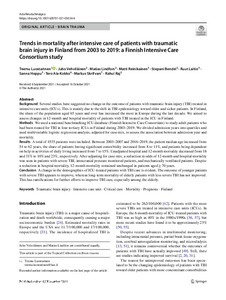Trends in mortality after intensive care of patients with traumatic brain injury in Finland from 2003 to 2019: a Finnish Intensive Care Consortium study
Skrifvars Markus; Vehviläinen Juho; Reinikainen Matti; Lindfors Matias; Bendel Stepani; Raj Rahul; Laitio Ruut; Ala-Kokko Tero; Luostarinen Teemu; Hoppu Sanna
https://urn.fi/URN:NBN:fi-fe2022012710648
Tiivistelmä
Background Several studies have suggested no change in the outcome of patients with traumatic brain injury (TBI) treated in intensive care units (ICUs). This is mainly due to the shift in TBI epidemiology toward older and sicker patients. In Finland, the share of the population aged 65 years and over has increased the most in Europe during the last decade. We aimed to assess changes in 12-month and hospital mortality of patients with TBI treated in the ICU in Finland.
Methods We used a national benchmarking ICU database (Finnish Intensive Care Consortium) to study adult patients who had been treated for TBI in four tertiary ICUs in Finland during 2003-2019. We divided admission years into quartiles and used multivariable logistic regression analysis, adjusted for case-mix, to assess the association between admission year and mortality.
Results A total of 4535 patients were included. Between 2003-2007 and 2016-2019, the patient median age increased from 54 to 62 years, the share of patients having significant comorbidity increased from 8 to 11%, and patients being dependent on help in activities of daily living increased from 7 to 15%. Unadjusted hospital and 12-month mortality decreased from 18 and 31% to 10% and 23%, respectively. After adjusting for case-mix, a reduction in odds of 12-month and hospital mortality was seen in patients with severe TBI, intracranial pressure monitored patients, and mechanically ventilated patients. Despite a reduction in hospital mortality, 12-month mortality remained unchanged in patients aged >= 70 years.
Conclusion A change in the demographics of ICU-treated patients with TBI care is evident. The outcome of younger patients with severe TBI appears to improve, whereas long-term mortality of elderly patients with less severe TBI has not improved. This has ramifications for further efforts to improve TBI care, especially among the elderly.
Kokoelmat
- Rinnakkaistallenteet [19207]
